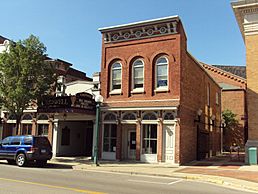Croswell Opera House facts for kids
|
Adrian Union Hall-Croswell Opera House
|
|
|
U.S. Historic district
Contributing property |
|
 |
|
| Location | 129 East Maumee Street Adrian, Michigan |
|---|---|
| Built | 1866 |
| Architect | H.N. White (1866); John C. Brompton (1919 and 1921) |
| Part of | Downtown Adrian Commercial District |
| NRHP reference No. | 85000839 |
Quick facts for kids Significant dates |
|
| Added to NRHP | April 18, 1985 |
The Croswell Opera House is a very old and special theater located at 129 East Maumee Street in Adrian, Michigan. It's known as the oldest theater in Michigan and one of the oldest theaters in the entire United States that has been open non-stop! It became a Michigan Historic Site in 1976 and was added to the National Register of Historic Places in 1985. This means it's an important building protected for its history.
Contents
The Croswell's Story
How It All Began
The Croswell Opera House, first called Adrian Union Hall, opened in 1866. It was built with money from a company that included Charles Croswell, who later became Michigan's governor. The very first public event there was a talk by John Bartholomew Gough on March 19, 1866.
In its early years, the hall was used for many different things. It hosted concerts, talks, festivals, and plays. Both traveling groups and local amateur actors performed there. Many famous people visited the opera house, including Susan B. Anthony, Elizabeth Cady Stanton, and Frederick Douglass. Other well-known visitors included Thomas Nast, Henry Ward Beecher, and Ralph Waldo Emerson. In the 1800s, performers like Edwin Booth, John Philip Sousa, and Buffalo Bill Cody appeared on its stage. Later, in the early 1900s, Mrs. Patrick Campbell and Maude Adams also performed there.
The Croswell has had several names. At first, the local newspaper often called it "New Hall." Around 1869, people started calling it the Opera House. When Charles Croswell stopped being governor in 1881, he bought many shares in the Adrian Union Hall Company. He became the main owner and asked his son, Charles Croswell Jr., to manage the theater. That's when it became known as Croswell's Opera House. Even after Charles Croswell Jr. left his job in 1886, the name "Croswell Opera House" stayed.
A new entrance area was added to the building in 1882. In 1885, the theater got its first two electric lights. By 1895, the entire theater had electric lighting. The lighting system was designed by Harry A. Fee. In 1896, the stage was made bigger and the roof above it was raised. This was done to handle the larger and more complex plays of that time.
The Movie Theater Years
In the early 1900s, movie theaters became very popular, and the Croswell faced a lot of competition. In 1919, Harry Angell and Robert Codd bought the theater. They made two big changes. The first change, in 1919, turned the Croswell into a movie house. A long, arcade-style lobby was added to the front, along with a projection booth for showing films.
Then, in 1921, the old balcony was removed and a new one was built. The entire inside of the theater was redesigned. It was during this renovation that the Croswell got its modern look.
In 1927, a company called W.S. Butterfield Theatres leased the Croswell and ran it for the next 40 years. The theater was set up for sound in 1929. The first "talking picture" shown there was Weary River.
During World War II, the Croswell helped raise over $1 million for the war effort. They held "war bond premieres" where tickets were not sold. Instead, you could only get in if you bought a new war bond. They also had charity toy drives and special movie showings for children where food was collected.
By the 1960s, the Croswell faced more competition from drive-in theaters and television. A large theater with only one screen, like the Croswell, was becoming difficult to run. In March 1967, the Butterfield company announced they would not continue their lease. The owner, Harry Angell, put the building up for sale. The last movie shown by Butterfield was The Sound of Music, which closed on September 16, 1967.
Live Theater Returns
When Butterfield decided to leave, the Croswell was in danger of being torn down. But Charlie Hickman, who owned a local company, bought the building. A new non-profit group was created to run the theater. The Croswell started its first summer season of live theater again in 1968. The first play was Neil Simon's Barefoot in the Park. Other plays that summer included Summer and Smoke, Oliver!, and Once More, With Feeling.
That fall, a new group called the Croswell Players was formed. They continued to offer theater shows during the fall, winter, and spring. Eventually, the summer and winter theater programs at the Croswell joined together.
In 1970, the tradition of bringing famous speakers to the Croswell was brought back. Speakers in the theater's Town Hall series, which ran until 1996, included Gloria Steinem, Helen Thomas, Arianna Huffington, Ralph Nader, Julian Bond, Art Linkletter, Jeane Dixon, Bella Abzug, Kitty Carlisle, Charlton Heston, and "Dear Abby" author Pauline Phillips.
In May 2015, a big project was announced to update the theater. These changes included new public areas, more restrooms, and improvements to make it easier for people with disabilities to use. Electrical and other building system upgrades were also planned. Construction started in 2016, and the theater reopened in May 2017. The 2017 season marked the Croswell's 50th summer as a theater that produces its own shows.
Theater Design
The Croswell was first designed by Horatio Nelson White. The building is 115 feet deep and 64 feet wide. The main audience room is 80 feet deep and 63 feet wide. It has a gallery (balcony) on three sides with three rows of seats. The theater was designed to comfortably seat 1,500 people. The gallery was built in a special way using trusses and iron ties, so it didn't need columns to hold it up. This gave everyone a clear view of the stage.
The stage is large, 30 by 32 feet, and was set up for plays with scenery and dressing rooms. The scenery could be moved using special machinery, which made scene changes smooth and quiet. The basement of the building had furnaces for heating, a large storage room, and a big dining room. The ceiling and walls were decorated with beautiful paintings. The design was meant to be elegant and tasteful, not overly fancy.
The Croswell's look changed several times over the years. A 14-foot addition was built onto the front of the theater in 1882. The stage roof was raised in 1896 to fit more complex scenery.
The renovations in 1919 and 1921 were led by architect J.C. Brompton. In 1919, a projection booth and a long, arcade-style lobby were added to the front. Before this, people had to walk down an alley and wait outside before a show. In 1921, the original horseshoe-shaped balcony was removed and replaced, and the entire inside of the theater was redesigned.
Some of the theater's special features include fancy plaster decorations around the audience area. There are also two tall towers on either side of the stage with decorative urns. Large panels on the walls are similar to those in Brompton's Riviera Theatre.
From 1921 until the 1970s, only small changes were made inside the Croswell. In 1976, a new section was added to the back of the theater for a scene shop and offices. Two buildings next to the Croswell's front lobby were bought in 1978 and 1979. These were added to the theater, creating space for rehearsals, more offices, and an art gallery. The theater was added to the National Register of Historic Places in 1985.
What's Happening Now
The Croswell is a theater that produces its own shows and is open all year. It puts on six to eight full-scale musicals each year, along with plays, children's theater, and sometimes concerts. It is owned by a non-profit group called the Croswell Opera House and Fine Arts Association. Jere Righter has been the artistic director since 2009.
Musicals
Most of the shows at the Croswell are musicals. For all of its full-length musicals, the theater uses a live orchestra, not recorded music.
New Shows
Besides well-known shows, the Croswell has also shown several brand new plays and musicals for the first time. These include:
- A Dragon's Tale, a musical by Michael and Betsy Lackey (1985).
- The Legend of Sleepy Hollow, a musical by Don Wilson and Dave Zabriskie (2004).
- Breakfast at Frannie's, a play by Terry Hissong (2009).
- Obsession, a musical version of the Frankenstein story, by Michael and Betsy Lackey (2011).
- The Family Digs, a play by Terry Hissong (2017).
Learning Programs
The Croswell offers many educational programs. These include summer camps for performing and learning about theater technology. They also put on an all-area high school musical and offer paid summer internships for college students. Plus, they have a variety of performances just for children.
Famous People Who Started Here
Some theater professionals who have a background at the Croswell include:
- Tobin Ost, a set designer who was nominated for a Tony Award in 2012 for his work on Newsies.
- Leah Crocetto, an opera singer who won the Metropolitan Opera National Council Auditions in 2010.
- Shonn Wiley, a member of the Chicago cast of Jersey Boys.



